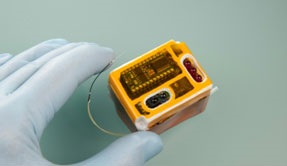CAMBRIDGE, MA- Draper Laboratory has demonstrated new advances miniaturizing in a drug delivery device that could help patients recover from the most common forms of hearing loss.
The lab’s progress on the intracochlear drug delivery device, including in the incorporation of a planar micropump that brings the system towards the miniaturization needed for clinical trials, is featured in the Feb. 21 issue of the journal Lab on a Chip.
 Draper is collaborating with the Massachusetts Eye and Ear Infirmary (MEEI) on the development of the device, which could address sensorineural hearing loss (SNHL), noise induced hearing loss, and other inner ear diseases by delivering precise quantities of one or more drugs in an automated, timed sequence directly into the fluid of the inner ear. Most other current and emerging approaches deliver drugs to the middle ear, require repeat injections, and depend on indirect transport through tissue to reach the inner ear.
Draper is collaborating with the Massachusetts Eye and Ear Infirmary (MEEI) on the development of the device, which could address sensorineural hearing loss (SNHL), noise induced hearing loss, and other inner ear diseases by delivering precise quantities of one or more drugs in an automated, timed sequence directly into the fluid of the inner ear. Most other current and emerging approaches deliver drugs to the middle ear, require repeat injections, and depend on indirect transport through tissue to reach the inner ear.
Draper’s method eliminates patient adherence issues, systemic side effects, and frequent office visits that are associated with many other approaches to hearing loss.
The device would be used in concert with drugs in development to treat hearing loss.
As described in the paper, the device is now a complete wearable system that provides pumping to and from the cochlea as well as a drug reservoir that allows for variable dosage.
“This is a major step toward the future miniaturization that will be required for an implant for humans, because it shows the approach we will use as we go forward and has the potential for further size reduction,” said Jeff Borenstein, Draper’s principal investigator for the project.
The device features a novel reservoir that is a circuit, rather than a vessel with a single outlet. Instead of emptying the vessel, the device pushes a small quantity of the treatment drug out one outlet, while drawing spent fluid in through a separate inlet, keeping total volume constant and avoiding stored pressure in the reservoir.
During in vitro testing, researchers tracked fluid as it moved from the device into a small well to make accurate measurement of dose delivery. Preclinical testing in vivo at MEEI used a drug that temporarily blocks hearing in order to demonstrate the device’s safety and efficacy.
Next steps include continued study of the effects of intracochlear drug delivery to ensure safety with long term use. Draper is also continuing to drive down the device’s size while making it more reliable and user friendly for collaborators to test with promising new drug compounds.
The project is funded by the National Institutes of Health (NIH) through its National Institute on Deafness and Other Communication Disorders (NIDCD) under grant #5 R01 DC006848-07.
About Draper Laboratory
Draper Laboratory, which celebrates 80 years of service to the nation in 2013, is a not-for-profit, engineering research and development organization dedicated to solving critical national problems in national security, space systems, biomedical systems, and energy. Core capabilities include guidance, navigation and control; miniature low power systems; highly reliable complex systems; information and decision systems; autonomous systems; biomedical and chemical systems; and secure networks and communications.
Source: https://www.draper.com/emailedAnnouncements.html#labonachip

